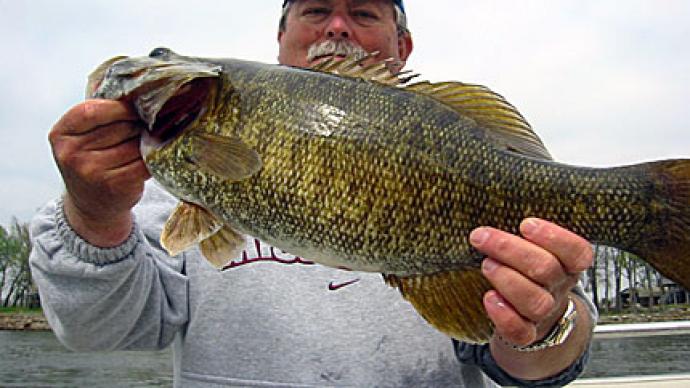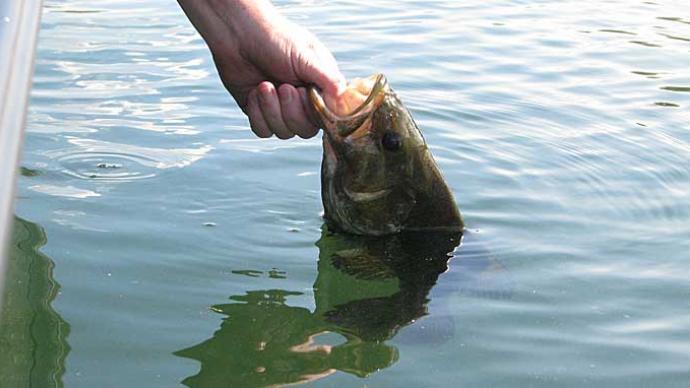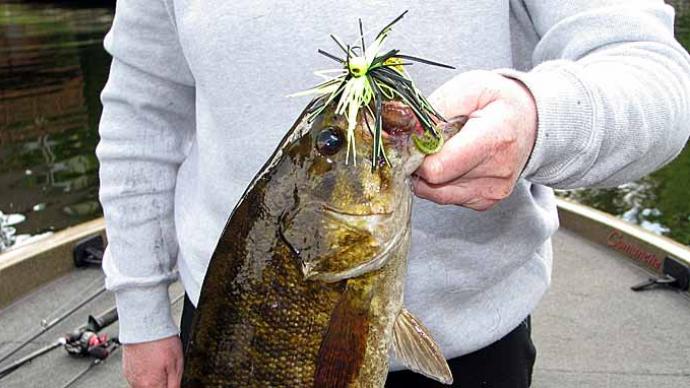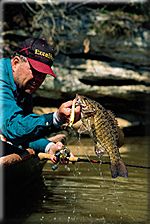
Arguably, bass are bass. These fish behave similarly whether a smallmouth in a high east Tennessee reservoir or a smallmouth in a sprawling New England lake. They migrate to shallow water in the spring, back out to deeper water in the summer, and then invade the shallows again as the water cools and winter approaches. Of course, various factors alter their daily routines, and no two lakes are identical. Still, a smallmouth in Alabama's Pickwick Reservoir responds to water temperature, the presence of bait, and the urge to spawn, much like a smallmouth in Lake Champlain.
Picking off a limit of fat smallmouths isn't that difficult, say three of the country's top professional anglers. It's as simple as following a few basic tenets of seasonal patterns.
Spring
During the earliest part of the season, Connecticut pro Terry Baksay narrows his search for spring smallmouths to one general area - the north end of a lake or a cove. Such areas are slightly warmer than the rest of the water, drawing baitfish and smallmouths from a long distance.
"If there is a southern wind, the warmer surface water will be pushed against the north bank, and if there is a cold northerly wind, a north bank will be protected, and it will warm up faster. You can be sure that every smallmouth in the area will be on the north bank in the spring," he explains. "It's not as hard as people make it out to be."
During the early spring period, Baksay says that larger smallmouths feed heavily on yellow perch, which have just finished spawning and are most vulnerable to predators. That's why he reaches for lures with a gold or perch pattern. One of his favorites is a No. 14 suspending Husky Jerk. It's a big lure - 5 ½ inches - but Baksay prefers to throw a large lure to target the biggest bass. He'll even use a No. 18 Rapala, particularly on windy days and when the fish are most active. Such a lure - that model is 7 inches - grabs the attention of the largest bass in the area.
"The fish seem to be oriented to looking up for food rather than on the bottom in the pre-spawn period. He explains that I don't do very well on tubes and other bottom-hugging baits in the early spring," he explains. "It's also important to remember that the fish tend to be schooled up this time of year. That's another reason I like fishing a jerkbait. It allows me to cover lots of water because some areas just don't have any fish, and then suddenly, you'll be into a whole bunch of them."
He looks for these fish in 5 to 10 feet of water but adds that they might be suspended at that depth over much deeper water. However, his jerkbait tactic works no matter where the fish are, so he tends to cover lots of water throughout those northern coves and bays until he figures out where the bass are that particular day.
Baksay's north bank pattern lasts well into the spring, but as the water approaches the low 50s, the fish tend to scatter as they search for suitable spawning habitat. The veteran pro believes that most smallmouths tend to spawn on the main lake, not in the backs of coves like many other anglers think, so he'll put his trolling motor on high and work his way down the shoreline hunting for fish.
He searches all over a lake for spawning bass but notes that smallmouths have a few basic needs for bedding. Besides the obvious - a sand or gravel bottom - Baksay looks for isolated stumps or rocks, anything the fish can utilize as cover.
"Smallmouths like to spawn against anything they can put their backs to. The bigger fish spawn first and are generally deeper than smaller bass. I've seen them in as little as 4 or 5 feet of water in stained lakes and as deep as 20 feet in real clear lakes," he notes.
Bedding smallmouths are arguably the easiest fish to catch. When they lock on their beds, they rarely leave and slash at anything that comes in, over, or past their nests. Baksay relies on several lures, including tubes, soft jerkbaits, and Zara Spooks.
"One of my favorite lures for bedding bass is a white or bubblegum Slug-Go," he says. "I'll throw it over the bed and just let it fall. The bright color helps me detect light bites, and when the lure disappears, I know she's got it."
Summer
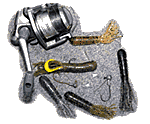
Two of the best all-around smallmouth lures are soft plastic tubes and grubs. These are particularly effective when the bass are bedding.
Anglers that stick to a shallow-water pattern as the water heats up will likely throw lures to empty water, says Arkansas pro Mark Rose. The veteran tournament angler typically backs off to deeper water when he searches for summer smallmouths, but he admits that there are instances when you can find some shallow fish in the dog days of summer.
"Current. You can find some nice bass in shallow water if you have some current. It doesn't matter if it's a river influence, tailrace, or power plant drawing water. If you can find good current, you can find some shallow smallmouths. Those shallow fish will be easier to find and catch than deep bass," he says.
Rose also likes overcast days, an event that brings baitfish up toward the surface with smallmouths in tow. According to the full-time pro, smallmouths gather in schools on such days and often take a topwater lure like a Strike King Splash Popper or a soft-plastic jerkbait.
Most of the time, however, Rose and anglers throughout smallmouth country are faced with the prospect of getting a lure down to fish holding in as much as 30 feet of water, even more. While that may seem like an enormous task, having a great day when the surface temperature soars is not out of the question.
"I'm going to look for deep rocky points, bluff-type points, sharp drop-offs, and shady bluffs," says Rose. "My favorite summer baits include Carolina-rigged French Fries and centipedes, Strike King Series 6 crankbaits, and drop-shot rigs. My favorite lure for summer drop-shotting is a Strike King Coffee Tube."
He says that smallmouths will typically hang on the sides of points, particularly main lake points near a river channel.
Baksay will target humps and drop-offs with watermelon tubes rigged on 3/8-ounce jig heads. And like Rose, he also uses drop-shot rigs. Baksay prefers a 3-inch, salt-and-pepper Slug-Go.
Both pros agree that a simple location change may be all it takes to find active bass if they aren't catching fish.
"They can bunch up in the summer, and I've found that they often school up by size. My son and I had a great day on a nearby lake during the early summer by throwing Zara Spooks and white Fin-S soft jerkbaits to a long point in 30 to 40 feet of water. The fish were suspended and were coming up to the surface. We caught 60 fish in about four hours. My best five probably weighed 19 pounds, and his best five went about 21 pounds," he recalls.
Fall
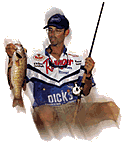
Crankbaits, spinnerbaits, and hard jerkbaits help Mike Iaconelli cover lots of water in a hurry.
Mike Iaconelli offers no hesitation when asked to choose his favorite season to chase smallmouths.
"Fall," he says. "I've won many tournaments on smallmouth lakes in the fall. It's my favorite time to fish in a lake with many smallmouths. It doesn't matter if it's Lake St. Clair, Champlain, Thousand Islands, or even a southern smallmouth reservoir. The fish do the same thing, and you can load up on big fish."
Locating baitfish is the key to catching a single smallmouth when the leaves fade from vibrant green to a rich assortment of reds, golds, and oranges. Since baitfish - shad, alewives, ciscoes, or smelt - migrate with the seasons, smallmouths will follow.
"Smallmouths become very predictable in the fall. They know that lean times are coming up and want to feed as heavily as possible before winter sets in. If you find bait in the fall, you can be sure that smallmouths are near," Iaconelli explains.
His tactics are pretty straightforward, and he relies on a handful of baits to put a limit of fat smallmouths in his livewell, just about all the time in September and October. Before he picks up a rod and even backs his boat into the water, Iaconelli studies a map and looks for a few critical ingredients.
He likes shallow shelves adjacent to deeper water, particularly flats that drop sharply. He also likes rocky humps and shoals, particularly those with patches of grass growing among the rocks. Although the fish will be in various depths, he generally finds them in 8 to 12 feet of water in the fall.
"The best fall areas are similar to the best spots in the spring," Iaconelli adds.
Once he finds those areas, the New Jersey resident reaches for a 3/4-ounce Mann's Ti Classic spinnerbait, a Mann's crankbait, or a bright-colored hard jerkbait like a clown-colored Rapala Husky Jerk. Each of these lures allows him to cover a lot of water quickly. That's important, he notes, because smallmouths gather in big schools - as many as 50 fish - leaving many areas utterly void of bass. With a spinnerbait, crankbait, or jerkbait, he can cover an area in one or two passes to determine if any bass are around. Still, he modifies his heavy spinnerbaits by replacing the factory blades with smaller blades. That allows him to burn the lure just under the surface. Larger blades tend to pull the lure to the top as it is retrieved faster, but Iaconelli insists that keeping the lure just under the surface is essential.
"During a major tournament on Champlain one fall, I threw a jerkbait to a flat and caught about a 2-pounder. As I got it close to the boat, I saw this black cloud following it. It was a huge school of 2- to 4-pound smallmouths," Iaconelli recalled.
He won that tournament not by throwing the jerkbait exclusively but by utilizing follow-up lures to target those fish that weren't interested in chasing a fast-moving bait. Follow-up patterns are vital to catching more fish from an area, and Iaconelli typically throws a soft plastic tube to work an area slowly and thoroughly.
Winter
Although northern bass anglers must rely on an ice augur to target smallmouths in the winter, recreational bass anglers throughout the South can chase these fish right through the coldest months of the year. Jerry Farmer, a guide, tournament angler, and partner in a boat dealership in Bristol, Tenn., heads for his favorite East Tennessee lakes every chance. And, more than likely, he's going to catch some fish.
"The fish will suspend over structure like a point or hump, or they will suspend next to a bluff wall or a ledge. The more irregular the features, the better, it seems," Farmer says.
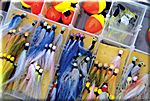
Dedicated float n' fly anglers use a variety of colors and sizes, switching often until they find the right combination for the day.
One of the best baits for catching reservoir smallmouths in the winter is a float n' fly, a simple rig that consists of a small hair or feather jig, or "fly," and a small bobber. Farmer uses this tactic all winter and catches some impressive stringers of smallmouths.
The float n' fly allows the small jig, which imitates a small shad, to hang among or slightly above suspended bass - those that aren't willing to chase a fast-moving bait or aren't close enough to the bottom to pick up a jig or tube. Farmer uses a long rod, a 9- or 10-footer, and places his jig anywhere from 8- to 15 feet below the bobber. He allows the bait to sit still for 10 or 15 seconds before he reels it in and casts it to another spot.
Smallmouth bass may stump the country's best professional anglers occasionally, but not very often. Why not? Rose, Baksay, and Iaconelli agree that smallmouths are pretty predictable no matter where you fish for them. Follow these seasonal tips, and you'll catch some quality bass.
Content provided by Bass Fishing Magazine, the official publication of FLW Outdoors
BassResource may receive a portion of revenues if you make a purchase using a link above.


